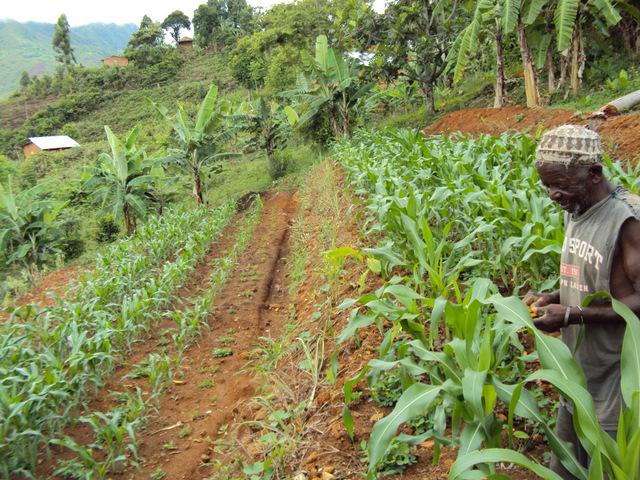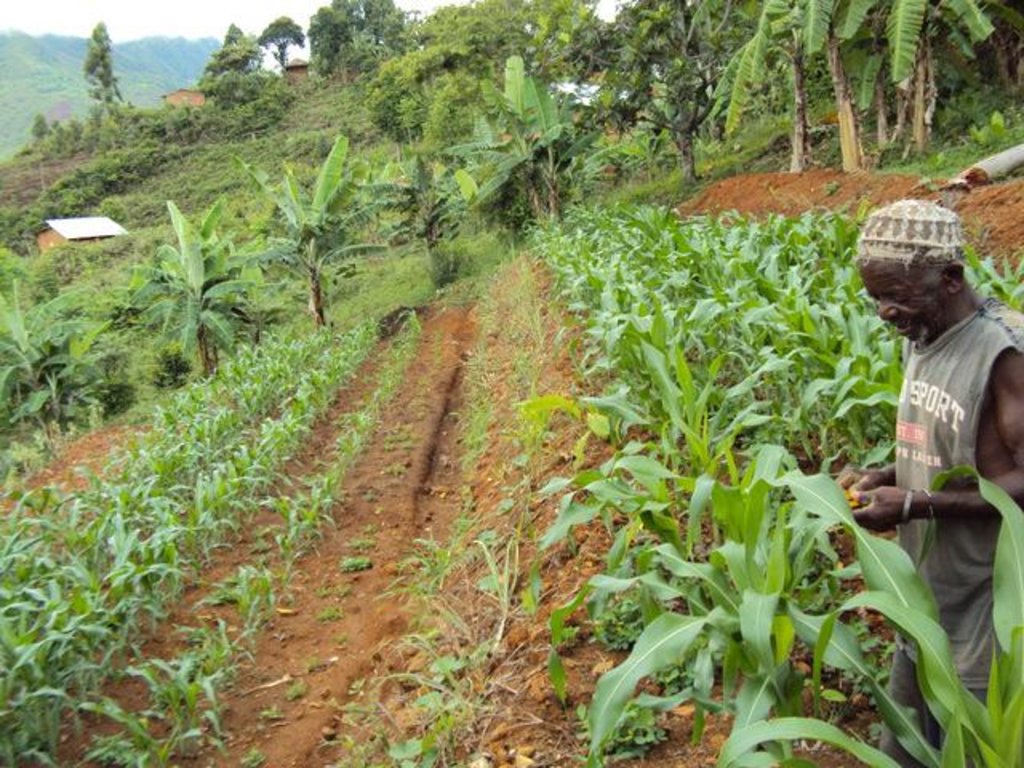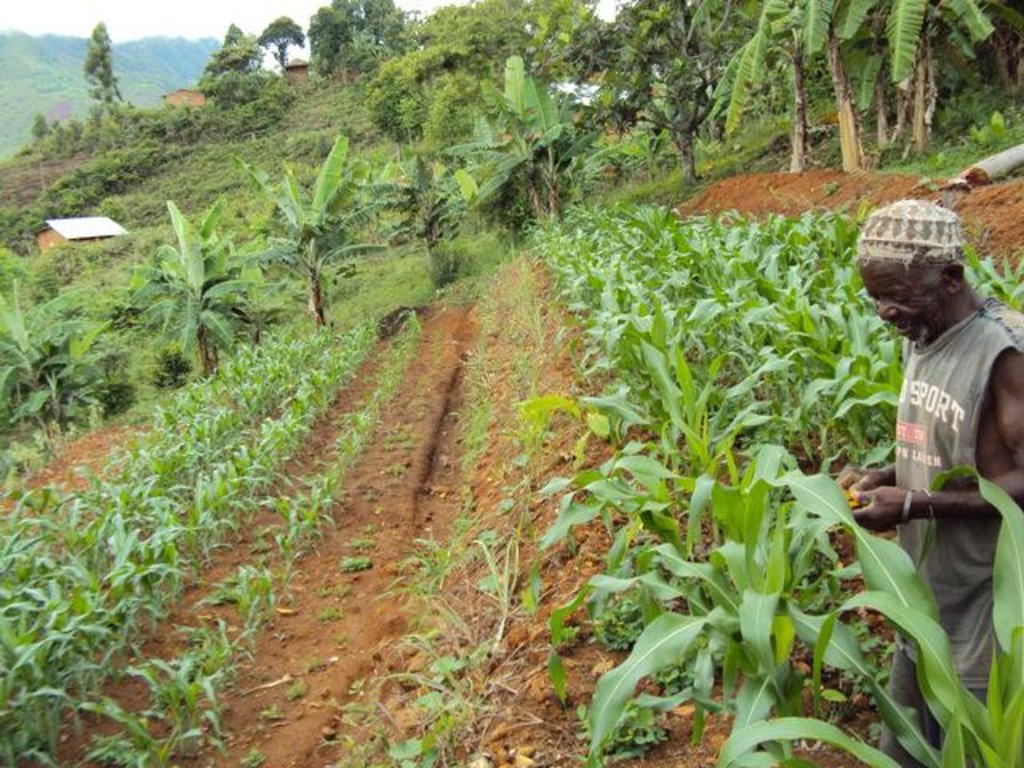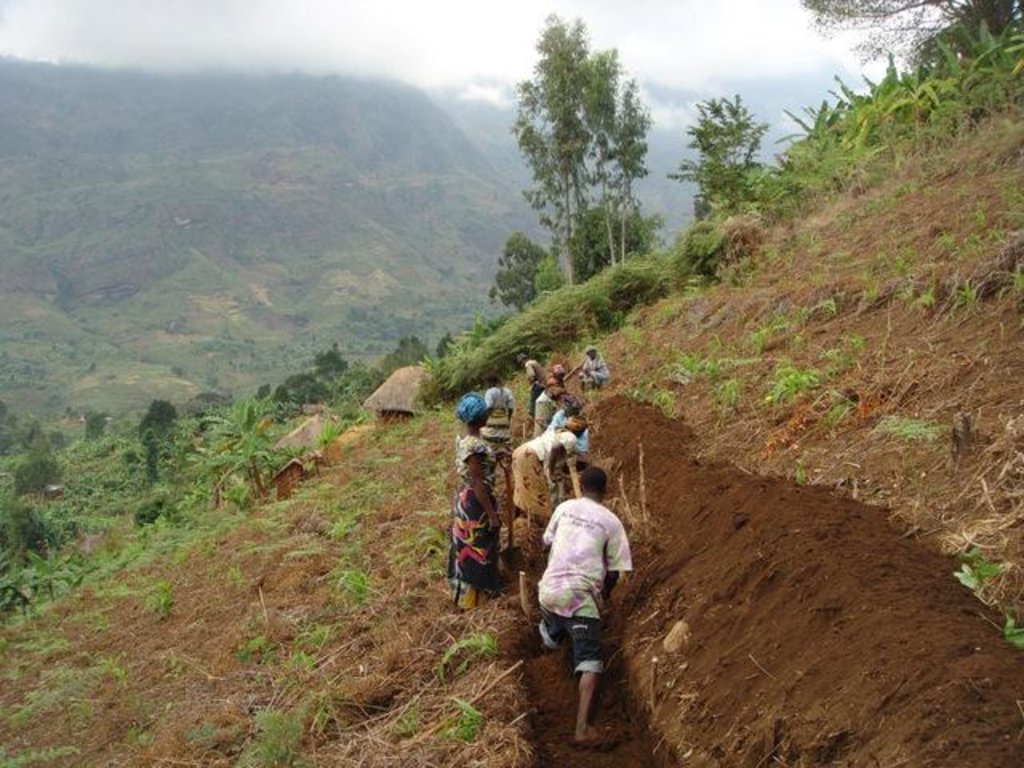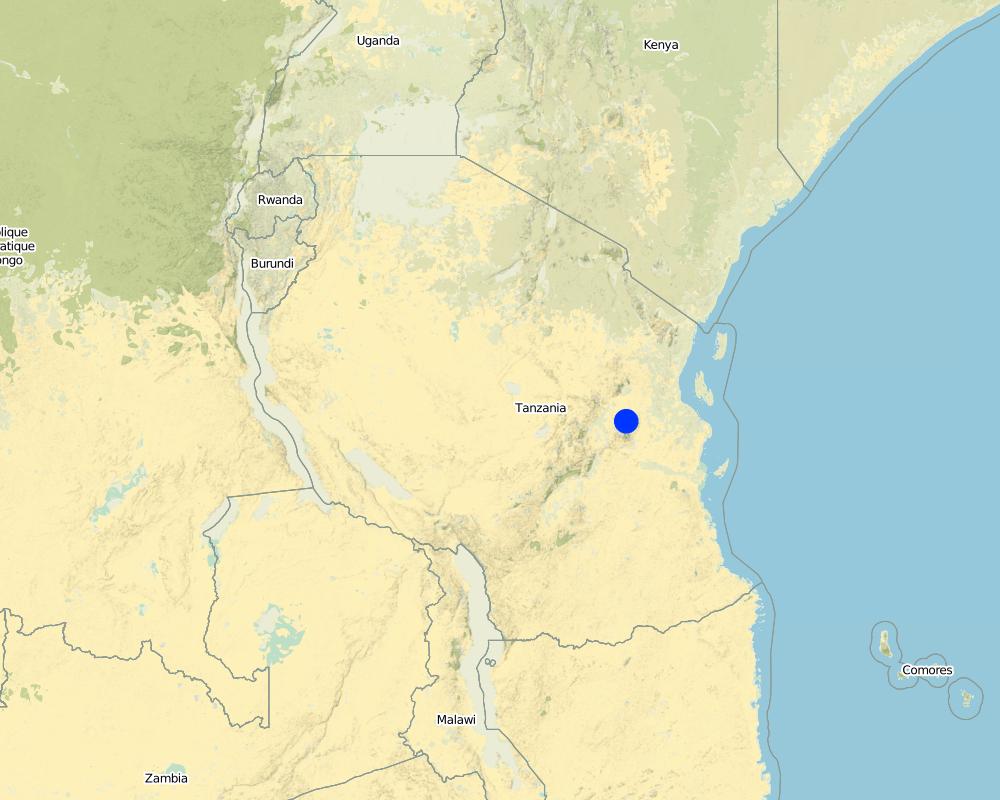Equitable Payments for Watershed Services [República Unida da Tanzânia]
- Criação:
- Atualização:
- Compilador/a: Philippe Zahner
- Editor: –
- Revisor: Fabian Ottiger
approaches_2567 - República Unida da Tanzânia
Veja as seções
Expandir tudo Recolher tudo1. Informação geral
1.2 Detalhes do contato das pessoas capacitadas e instituições envolvidas na avaliação e documentação da abordagem
Especialista em GST:
Dosteus Lopa
dosteus.lopa@co.care.org
CARE International in Tanzania
Morogoro
República Unida da Tanzânia
Nome da(s) instituição(ões) que facilitou(ram) a documentação/avaliação da Abordagem (se relevante)
Swiss Agency for Development and Cooperation (DEZA / COSUDE / DDC / SDC) - SuíçaNome da(s) instituição(ões) que facilitou(ram) a documentação/avaliação da Abordagem (se relevante)
CARE International (CARE) - Estados Unidos1.3 Condições em relação ao uso da informação documentada através de WOCAT
O/a compilador/a e a(s) pessoa(s) capacitada(s) aceitam as condições relativas ao uso de dados documentados através da WOCAT:
Sim
2. Descrição da abordagem de GST
2.1 Descrição curta da abordagem
Equitable Payments for Watershed Services (EPWS) is a programme using Payments for Ecosystem Services (PES) to improve rural livelihoods.
2.2 Descrição detalhada da abordagem
Descrição detalhada da abordagem:
Aims / objectives: Incentive mechanisms are used to reward upstream landowners for maintaining a beneficial land use or for adapting a particular land use practice which affects the availability and/or quality of downstream water resources. The EPWS approach has enormous potential to advance a new conservation revolution based on a compensation mechanism encouraging and financing conservation efforts as well as improving the livelihoods of the rural poor. EPWS aims to spread SLM technologies to communities, to raise awareness of the benefits of SLM and to improve land productivity. Farmer groups are formed to lead the implementation of SLM.
Methods: The approach includes supervision, support and training of farmers to ensure appropriate implementation of SLM and efficient soil erosion control. Methods include demonstration plots and farmer-to-farmer extension. Capacity building to farmers (on gender mainstreaming, good governance and relevant laws and policies) and monitoring of hydrological and livelihood status are important components of the approach. Efforts to ensure good women integration resulted in a relatively high proportion within the farmer groups (>35%). A payment mechanism has been established to compensate farmers for delivering watershed services (in form of freshwater) through implementation of SLM. Compensation payments – paid in cash and through material support – are made first to establish land use changes, and thereafter for service delivery and maintenance. They are mainly covered through international donors (DANIDA) and ‘buyers’ from the private sector, investing in watershed management.
Role of stakeholders: The EPWS team consisting of CARE International, WWF staffs and short-term workers (such as students) is always involving government staff in various activities to induce them to knowledge on EPWS in particular and the PES concept at large.
Other important information: This PES approach is very new in the country and there is little expertise within the government -which therefore needs to take deliberate efforts to groom experts through seminars and courses on PES mechanisms and its operationalisation
2.3 Fotos da abordagem
2.5 País/região/locais onde a abordagem foi aplicada
País:
República Unida da Tanzânia
Especificação adicional de localização:
Morogoro
Map
×2.7 Tipo de abordagem
- Baseado em projeto/programa
2.8 Principais metas/objetivos da abordagem
The Approach focused mainly on SLM with other activities (Improvement of livelihoods, improvement of hydrological system)
Improve livelihoods through SLM / Improvement of hydrological system / Mechanism to ensure effectiveness, growth and sustainability of EPWS / Enhance quality of program implementation
The SLM Approach addressed the following problems: Land cover changes due to extensive cultivations / Deforestation and forest degradation / Soil erosion, loss of soil fertility / Low storage capacity of the Uluguru Mountains due to land cover change / Declining amount of available water in the river coming from Uluguru Mts / Increased run-off and sediment load in water system due to bare lands
3. Participação e papel das partes interessadas envolvidas
3.1 Partes interessadas envolvidas na abordagem e seus papéis
- Usuários de terra/comunidades locais
Efforts to ensure good women integration resulted in a relatively high proportion within the farmer groups (>35%).
- Especialistas em GST/ consultor agrícola
experts on hydrology, GIS, SWC, economics, forests, etc.
- Organização não governamental
DAWASCO
- Setor privado
Coca Cola KLtd
- Governo local
Morogoro district council
district commissioners, ward councillors
- Organização internacional
DANIDA, CARE International Tanzania, WWF Tanzania
3.2 Envolvimento do usuários de terra/comunidades locais nas diferentes fases da abordagem
| Envolvimento do usuários de terra/comunidades locais | Especifique quem estava envolvido e descreva as atividades | |
|---|---|---|
| Iniciação/motivação | Nenhum | |
| Planejamento | Participativo | |
| Implementação | Apoio externo | Farmers are being compensated (paid in cash) for labour and area provided for the implementation of SLM (opportunity costs). Material support through manure, seeds and working tools is given as well. |
| Monitoramento/avaliação | Nenhum | |
| Research | Nenhum |
3.4 Decisão sobre a seleção de tecnologia/tecnologias de GST
Especifique quem decidiu sobre a seleção de tecnologia/tecnologias a serem implementadas:
- Principalmente especialistas em GST, após consulta com usuários da terra
Explique:
Interactive implementation and decision making; participatory feasibility studies to identify the core problems; PRA to identify and agree on SLM technologies; government staff was involved in various activities e.g. planning, training, data collection and analysis, extension, etc.
Decisions on the method of implementing the SLM Technology were made by mainly by land users supported by SLM specialists
4. Suporte técnico, reforço das capacidades e gestão do conhecimento
4.1 Reforço das capacidades/ formação
Foi oferecida formação aos usuários da terra/outras partes interessadas?
Sim
Especifique quem foi capacitado:
- Usuários de terra
Tipo de formação:
- Agricultor para agricultor
- Áreas de demonstração
Assuntos abordados:
practical skills on SLM measures, leadership skills, governance, gender mainstreaming, policies and laws to ensure their understanding on the implementation of the EPWS project in their locality
4.2 Serviço de consultoria
Os usuários de terra têm acesso a um serviço de consultoria?
Sim
Especifique se foi oferecido serviço de consultoria:
- nas áreas dos usuários da terra
Descreva/comentários:
Key elements: technical support on monitoring, provision of extension services for improved land use, situation analysis, awareness creation, capacity building on legal issues and mapping of interventions; People involved: University, foresters, hydrologists, Ministry of agriculture, land use planners
4.3 Fortalecimento da instituição (desenvolvimento organizacional)
As instituições foram fortalecidas ou estabelecidas através da abordagem?
- Não
4.4 Monitoramento e avaliação
Monitoramento e avaliação são partes da abordagem?
Sim
Comentários:
bio-physical aspects were monitored through measurements
socio-cultural aspects were monitored through observations
economic / production aspects were monitored through observations
4.5 Pesquisa
A pesquisa foi parte da abordagem?
Sim
Especifique os tópicos:
- Sociologia
- Economia/Marketing
- Ecologia
Dê mais detalhes e indique quem realizou a pesquisa:
Research is a main part of PES as an approach to facilitate SLM adoption and has been very effective in guiding programme design; it included SLM assessment, hydrological analysis, economic analysis, social and livelihoods assessment, etc. All interventions applied were proposed by research conducted before and during implementation.
Research was carried out on-farm
5. Financiamento e apoio material externo
5.1 Orçamento anual para o componente de GST da abordagem
Caso o orçamento exato seja desconhecido, indique a faixa:
- 100.000-1.000.000
Comentários (p. ex. principais fontes de recursos/principais doadores):
Approach costs were met by the following donors: international (DANIDA): 60.0%; private sector ('buyers' of ecosystem service): 9.0%; local community / land user(s) (through labour power): 31.0%
5.2 Apoio financeiro/material concedido aos usuários da terra
Os usuários da terra receberam apoio financeiro/material para a implementação de tecnologia/tecnologias?
Sim
5.3 Subsídios para entradas específicas (incluindo mão-de-obra)
- Agrícola
| Especifique quais entradas foram subsidiadas | Em que medida | Especifique os subsídios |
|---|---|---|
| Sementes | Parcialmente financiado | |
| Fertilizantes | Parcialmente financiado | |
Se a mão-de-obra pelos usuários da terra foi uma entrada substancial, isso foi:
- Pago em dinheiro
Comentários:
Farmers are being compensated (paid in cash) for labour and area provided for the implementation of SLM (opportunity costs). Material support through manure, seeds and working tools is given as well.
5.4 Crédito
Foi concedido crédito segundo a abordagem para atividades de GST?
Não
6. Análise de impactos e declarações finais
6.1 Impactos da abordagem
A abordagem auxiliou os usuários da terra a implementar e manter as tecnologias de GST?
- Não
- Sim, pouco
- Sim, moderadamente
- Sim, significativamente
increased production
A abordagem concedeu autonomia aos grupos social e economicamente desfavorecidos?
- Não
- Sim, pouco
- Sim, moderadamente
- Sim, significativamente
women have gained training in improving land use practices
Did other land users / projects adopt the Approach?
- Não
- Sim, pouco
- Sim, moderadamente
- Sim, significativamente
Upscaling to neighbouring villages will be facilitated by the establishment of networks of farmers groups to receive training by local extension services. A steering committee, with representatives of the farmers, investors and government offices will facilitate replication in other parts of the country.
Did the Approach lead to improved livelihoods / human well-being?
- Não
- Sim, pouco
- Sim, moderadamente
- Sim, significativamente
Did the Approach help to alleviate poverty?
- Não
- Sim, pouco
- Sim, moderadamente
- Sim, significativamente
through change of crop production
6.2 Principal motivação dos usuários da terra para implementar a GST
- Pagamentos/subsídios
- Afiliação a movimento/projeto/grupo/rede
- Consciência ambiental
- well-being and livelihoods improvement
6.3 Atividades de sustentabilidade de abordagem
Os usuários da terra podem manter o que foi implementado através da abordagem (sem apoio externo)?
- Sim
Caso afirmativo, descreva como:
Participant land users can continue the activity without additional support- maintenance costs are low and the technologies will improve productivity and resilience of farming system. Upscaling to neighbouring villages will be facilitated by the establishment of networks of farmers groups to receive training by local extension services. A steering committee, with representatives of the farmers, investors and government offices will facilitate replication in other parts of the country.
6.4 Pontos fortes/vantagens da abordagem
| Pontos fortes/vantagens/oportunidades na visão do/a compilador/a ou de outra pessoa capacitada |
|---|
| PES as an additional argument for supporting property claims |
| To ensure services are delivered and payments are made and a reliable monitoring mechanism has been put in place |
| Poor people are in the centre of the objectives |
| Approach rewards land users for providing watershed services |
| PES as an incentive for conservation, helping to change land users’ vision towards improved land management |
| Once measures are applied they are simple and cheap to maintain |
6.5 Pontos fracos, desvantagens da tecnologia e formas de superá-los
| Pontos fracos/vantagens/riscos na visão do/a compilador/a ou de outra pessoa capacitada | Como eles podem ser superados? |
|---|---|
| May reduce the effectiveness of non-incentive based approaches as people will now demand rewards/payments | awareness creation is important to all players including government and local communities |
| Payments / rewards are realised before service delivery | ensure integration of PES with other approaches to ensure effectives short and long term benefits. Paying labour cost upfront while waiting for the service delivery rewards |
7. Referências e links
7.1 Métodos/fontes de informação
- visitas de campo, pesquisas de campo
- entrevistas com usuários de terras
Links e módulos
Expandir tudo Recolher tudoLinks
Não há links
Módulos
Não há módulos


